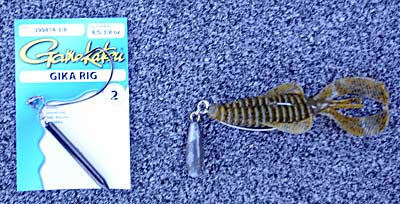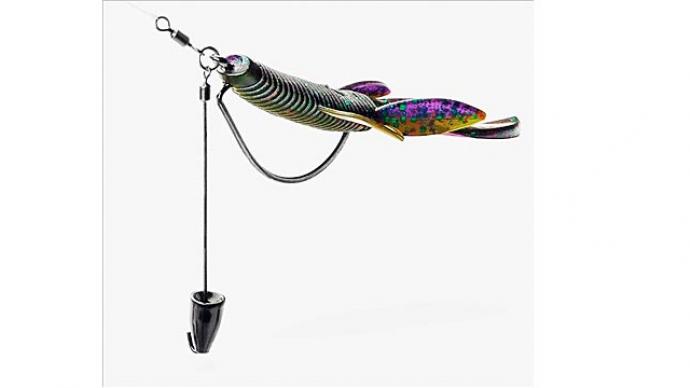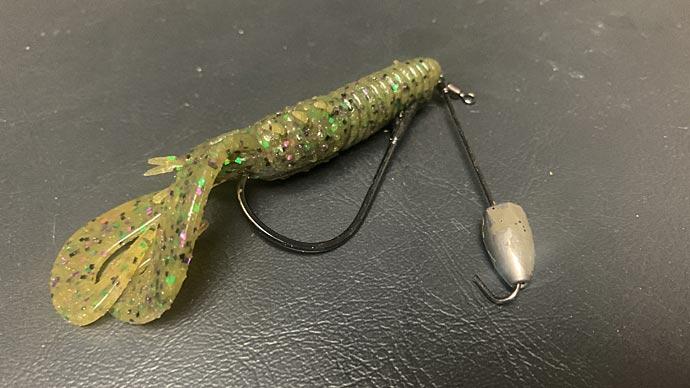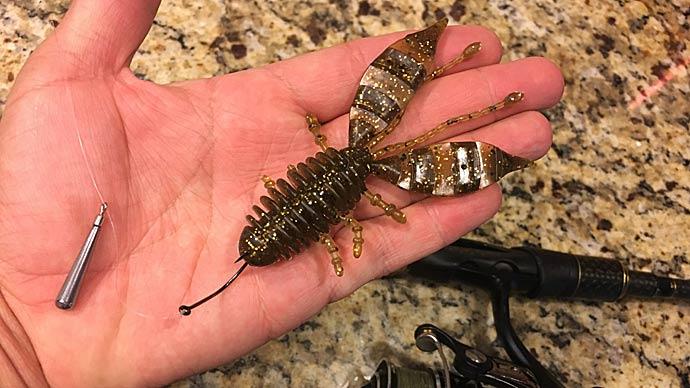
While other Japanese techniques have become popular among American bass anglers, the Jika rig has remained relatively unknown.
Long-time bass pro Stacey King has used the Jika rig to catch bass for over ten years. “It has never taken off very big here, but I like it,” King says. “I have caught lots of fish on it over the years.”
The Jika rig comprises an extra-wide gap hook and a weight connected to the hook eye with a split ring. This allows the weight to hang below the bait rigged on the hook and to move independently of the bait. Bass Pro Shops labels its version of the rig as the Zeka Rig, and Gamakatsu offers a Gika Rig, which is the same setup.
The Jika rig is similar to the Tokyo rig except that the weight on a Tokyo rig is attached to about a 2-inch dropper wire connected to the hook's eye. “So the Tokyo rig will set up just a shade higher off the bottom,” King says.
“One of the great advantages to the Jika rig is it has a very vertical fall,” King says. “It falls straight down, whereas a Texas rig or something like that tends to pendulum back to you more. It fishes well in cover because you can vertical fish it down through any aquatic vegetation, brush, or anything like that.”

King also likes the Jika rig over a jig or a Texas rig because the soft plastic lure freely swings off the rig's back end to give the lure a “little more lively action.” King prefers fishing the Jika rig over a jig sometimes because the rig presents a different look and fall than the jig. The rig also allows the plastic bait to flutter more, whereas with a jig, he has to shake to the lure to create more action.
The Missouri pro attaches a beaver-style bait on his Jika rig most of the time but will occasionally attach a plastic craw or a magnum-sized plastic worm to the rig. Similar to the Tokyo rig, the Jika rig allows King to use a variety of weight sizes and styles. The Gamakatsu Gika Rig is packaged with a cylinder-shaped weight, and King has made homemade versions of the Jika rig with various sinker styles.
King’s favorite weight sizes for the Jika rig are 3/8- and 1/2-ounce sinkers. The 12-time Bassmaster Classic qualifier suggests another advantage of the Jika rig. It can use a lighter weight than other rigs because it is attached to the hook and falls vertically for a faster sink rate. “So you can get away with a 3/8-ounce weight on the Jika rig, whereas you would need a 1/2-ounce on a Texas rig,” King says.
The Jika rig also can be equipped with various hook sizes. King favors a 2/0 extra-wide gap (EWG) hook for rigging small plastic craws and upgrades to a 4/0 EWG hook for beaver baits and a 5/0 EWG hook for giant worms.
King likes to pitch the Jika rig to standing timber, such as hardwood or cedar trees, on his home waters of Table Rock Lake. “This particular rig shines in that situation,” he says.
King also favors pitching the rig into man-made brush piles. “You can drop it down through a brush pile, and it just goes straight down into it,” he says. “Then you can shake it, crawl it over a limb, and let it fall straight back down again. It draws a lot of strikes that way.”
The rig is also great for punching through matted vegetation. King claims he can punch through the vegetation with a 3/8-ounce weight on the Jika rig, whereas he has to use a 3/4- or 1-ounce weight on a Texas rig for the same result.
The weight attached close to the hook makes the Jika rig ideal for fishing the bottom, but King notes you can also catch suspended fish with the rig. The way he presents the Jika rig depends on what he is fishing. “If you are fishing grass or cover of some sort, you will want to drop it through that cover and then shake that bait, raise it up and down, shake it a few more times and then bring it out and pitch it again,” King says. “But if you are casting the bait, you fish it primarily like you would a jig or a Texas rig by just dragging it along the bottom and shaking it a little bit.
“I have also caught a lot of fish using a great big worm (10 to 13 inches) on it and swimming it,” King says. “I just throw it out and let it go to the bottom and then just pick it up and start swimming it right above the bottom.”
The two-time B.A.S.S. winner notes he has caught bass from as shallow as 0 feet to as deep as 50 feet. “It shines when you are fishing the 15- to 30-foot zone because it just drops straight down and goes through the cover to get right to the bottom,” King says.
King suggests the rig will produce in any water color, weather condition, or season. The Missouri pro suggests he fishes the rig in the same situations as he would a jig or a Texas-rigged bait. “There is not much limit to it,” he says. “You can fish it just about anywhere or any way you want to.”
The rig has produced numbers of largemouth, spotted, and smallmouth bass for King over the years, but he considers it mainly a big fish rig. “I have caught a lot of 5- and 6-pounders on it over the years,” he says. “It is just like fishing a jig. You will catch all sizes of fish on it depending on what is there and what is biting.”




